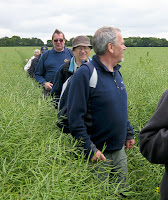It was a cool but humid morning as all, except Jim, set off on the first short stretch to St Nicholas Church, Great Hormead. Jim had stayed behind just in case any members of the public decided to join us - we had arrived in Hare Street much earlier than the publicised start time and were itching to get going. We were also expecting the Warden for this stretch of the walk, Ian Hurst to join us and Jim had to wait for him.

 We sat or walked around the churchyard amusing ourselves until Jim and Ian arrived. Off we set in earnest. Along pathways, across a meadow and down a narrow path onto the road in Great Hormead. As usual we turned in a direction so as to avoid the nearest pub.
We sat or walked around the churchyard amusing ourselves until Jim and Ian arrived. Off we set in earnest. Along pathways, across a meadow and down a narrow path onto the road in Great Hormead. As usual we turned in a direction so as to avoid the nearest pub.We followed the path blindly until Ian shouted, “Left turn!” just as we were about to walk up the drive to Hormead Hall! With a screech of brakes (just imagine it) we turned left. Our route eventually brought us out in the village of Anstey and to the Church of St George. Here we had a break for coffee.
It so happened that we had arrived on the day of a service to commemorate the loss of ten American air crew, killed when their bomber crashed behind the church shortly after take off from nearby Nuthampstead airfield during World War II. The incident was described to us by one of the Church Wardens as he waited for two veteran US Airmen to arrive for the service. There is a stained glass window in the Church to commemorate the airmen.
We left the churchyard and continued our walk through the village, past the Blind Fiddler Pub, recently renamed after a local blind fiddler who, local legend has it, walked back to the cave in which he lived, fiddling all the way. After entering the cave the music suddenly stopped - the fiddler was never seen again.
Continuing on, we passed the old village pump and eventually entered the aforementioned Nuthampstead Airfield where we crossed the main runway. We were told by Ian that the hard core used to build the runway came from a demolition site in London then, when the M1 motorway was being built the runway was broken up to provide hardcore for the motorway - that’s recycling!
Onwards, across the airfield, to the Woodman Inn for lunch. Outside the Woodman is a memorial to the USA 398th Bomb Group which was based at Nuthampstead during WW2. Here we were joined by Ken and Di Charles but, unfortunately, Liz Beardwell had to leave for another engagement.
After lunch we were again on our way - the longest part of the day’s walk lay ahead. After negotiating several bridges, kissing gates (no more demonstrations by the Berks!) and other obstacles our path took us across a field of oilseed rape, more than waist deep for some of our party.
In due course we found ourselves wondering down Barkway High Street. Barkway, once a coaching stop on the road from London to Cambridge is now famous for its Street Market and Village Pantomime. We stopped for a breather by the village pond. Moving on, further up the High Street we turned left into Church Lane, our path the taking us through the churchyard and hence onto the village of Reed where we emerged close to the Cabinet pub, despite the temptations we soldiered on to the village church where we again took a breather.
 A lovely little church where, we noted, one of our Club members is a Church Warden. After lazing in the sun, we walked on through the village to emerge on the Joint, the road running between the A10 and Barkway. We crossed the Joint and took a path across the fields, vaguely in the direction of Royston.
A lovely little church where, we noted, one of our Club members is a Church Warden. After lazing in the sun, we walked on through the village to emerge on the Joint, the road running between the A10 and Barkway. We crossed the Joint and took a path across the fields, vaguely in the direction of Royston. At its highest point we had a splendid panoramic view across towards Cambridge, the Fens and Ely. With Ray’s binoculars we were just able to make out Ely Cathedral.
As we walked into a dip, the sea of blue before us turned into a field of linseed. On past a new “farm-hand’s” house and a large array of sheds and farm machinery. It’s amazing what is within a mile or so of your own home that you didn’t know about. We walked up the other side of the dip to the top of the chalk escarpment that borders Royston, then down through the woods to the bottom of the Grange Estate, out onto Barkway Road, down the hill to Priory Gardens, the churchyard and our final goal, the Cross. The End.
Chris Hardy



















































